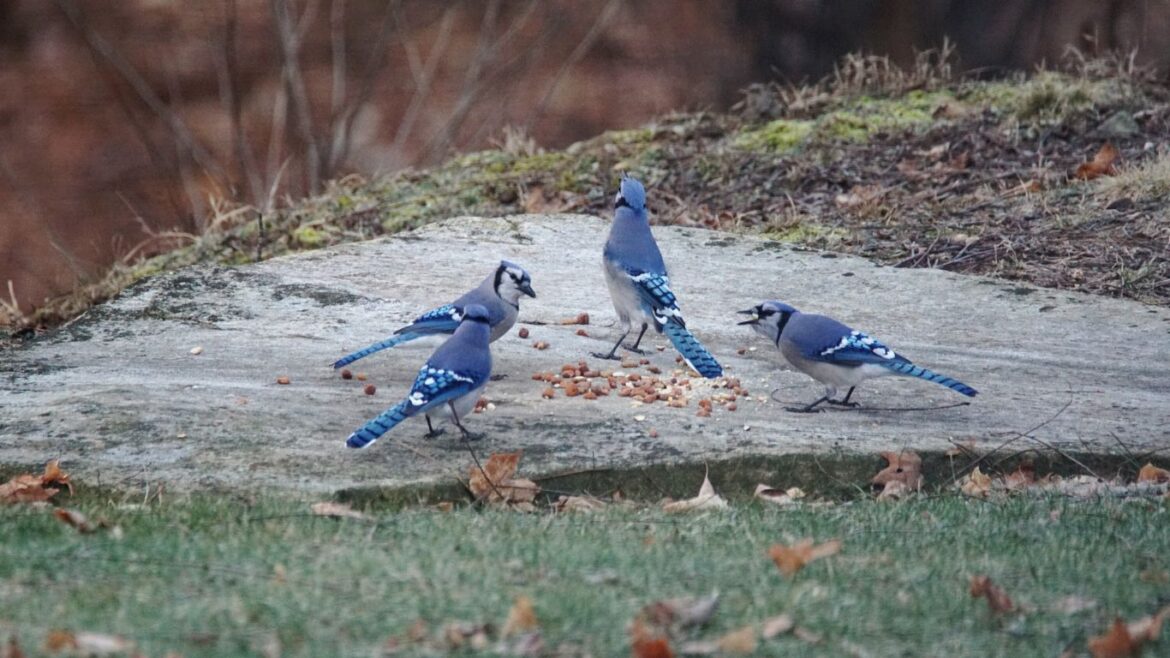If you’ve noticed an influx of blue jays in your yard recently, you’re not alone! These striking birds, known for their vibrant plumage and intelligent behavior, have been known to congregate in specific areas, especially during certain times of the year. But why are there so many blue jays in your yard? In this article, we’ll explore the possible reasons behind this phenomenon, ranging from seasonal migration to territorial behavior, and offer helpful tips on how to either attract or discourage them. Whether you’re fascinated by their presence or looking for ways to regain control of your space, read on to learn more!
The Attraction of Food Sources: Why Blue Jays Visit Yards
Blue jays are known to be opportunistic feeders, often seeking out areas rich in food. Understanding why they are attracted to your yard starts with identifying food sources. From seeds to small insects, blue jays are adaptable birds with varied diets.
What Do Blue Jays Eat?
Nuts:
Nuts are a primary food source for blue jays, especially acorns, which they collect and store for later consumption. These birds are particularly fond of hard-shelled nuts, using their strong beaks to crack them open. Nuts provide essential nutrients and energy, making them a vital part of their diet.
Fruits and Seeds:
Fruits and seeds are another important food source for blue jays. They are attracted to a variety of fruits, including berries and small fruits from trees, as well as seeds Omegle Working from plants like sunflowers. These foods offer essential vitamins and energy, supporting the birds’ nutritional needs throughout the year.
Insects and Small Animals:
Insects and small animals, such as caterpillars, beetles, and even small reptiles, form an essential part of a blue jay’s diet. These protein-rich foods provide crucial nutrients, especially during the breeding season. Blue jays are skilled hunters, often searching for these creatures in trees, bushes, or the ground.
They may be flocking to your yard because it provides these food sources in abundance. If you’ve recently planted fruit trees, or you have bird feeders, this could be a huge draw for them.
The Role of Seasonal Migration in Blue Jay Populations
One key reason for the sudden abundance of blue jays in your yard could be tied to seasonal migration. Blue jays are known to migrate during the fall and spring, typically heading south for the winter and returning in the spring. However, some blue jays stay year-round in milder climates.
Why Do They Gather?
Flocking Behavior:
Flocking behavior is common among Blue Jay Sound Like, especially during migration and the colder months. They gather in groups for safety, social interaction, and efficient foraging. Flocking helps protect them from predators and provides a sense of community. These groups can often be seen traveling or feeding together in large numbers.
Climate and Weather:
ChatGPT said:
If your yard is in an area that is part of their migration route, this could explain the seasonal influx.
Territorial Behavior and Nesting Habits of Blue Jays
Blue jays are territorial creatures, particularly when it comes to breeding and nesting. If you’ve noticed an increase in blue jay activity around your home, it could be because your yard is perceived as a prime nesting spot.
Why Are Blue Jays So Territorial?
Protection of Nesting Area:
Blue jays are highly protective of their nesting areas, especially during the breeding season. They defend their territory from other birds and predators to ensure the safety of their eggs and young. This territorial behavior helps maintain a secure environment for raising offspring and ensures successful reproduction.
Attractive Nesting Sites:
Blue jays are drawn to attractive nesting sites, typically in tall trees or dense shrubs that offer shelter and safety. These areas provide ample cover from predators and harsh weather. The birds also seek locations with enough space for building nests and raising their young in a secure, comfortable environment.
Understanding this territorial instinct is key to figuring out why they seem to be staying in your yard.
The Importance of Trees and Shelter in Blue Jay Habitats
Blue jays, like many birds, seek shelter and safety, especially when the weather turns unfavorable. Tall trees and dense vegetation offer the perfect cover for these birds to roost, hide from One Garlic Clove predators, and build their nests.
How Do Trees Affect Blue Jay Presence?
Roosting Spots:
Roosting spots are crucial for blue jays, offering them a safe place to rest and sleep, especially during the night or colder months. These spots are typically found in tall trees or thick shrubs that provide shelter from weather and predators, ensuring the birds’ safety and comfort while roosting.
Nesting Areas:
Nesting areas for blue jays are typically located in tall trees or dense bushes, offering safety from predators and harsh weather. These spots provide ample space for building sturdy nests, where blue jays lay their eggs and raise their young. Proximity to food sources also makes these areas ideal for nesting.
If your yard has large, mature trees, you might be offering exactly what these birds need to settle down for a while.
Blue Jays’ Social Behavior: Why They Flock Together
Blue jays are highly social creatures, and their group behavior plays a significant role in why you might be seeing more of them than usual. This social nature often leads to group gatherings, particularly when food is abundant and when they are preparing for migration.
Social Dynamics of Blue Jays
Flocking for Protection:
Flocking for protection is a key behavior for blue jays, especially during migration or in areas with potential predators. By gathering in groups, blue jays increase their chances of spotting threats and deterring predators. This social behavior enhances their survival by providing safety in numbers and offering mutual vigilance.
Mating Rituals:
Mating rituals in blue jays involve elaborate behaviors, including courtship displays and vocalizations. During the breeding season, males often offer food to females as a gesture of courtship. These rituals help strengthen pair bonds and ensure successful mating. Blue jays are monogamous, typically forming long-term partnerships for raising offspring.
The sudden surge in blue jay numbers in your yard might be related to their need for social interactions and protection during migration or breeding seasons.
How to Discourage Blue Jays from Visiting Your Yard
If you’d rather not have blue jays in your yard, there are ways to discourage their presence. While it’s difficult to completely remove them, here are some methods that might reduce their visits.
Tips to Discourage Blue Jays:
Limit Food Availability:
Limiting food availability is an effective way to discourage blue jays from frequenting your yard. By reducing or eliminating bird feeders that provide seeds, nuts, or fruit, you can make your yard less attractive to these birds. This approach forces them to search elsewhere for food sources.
Use Bird Deterrents:
Using bird deterrents, such as reflective tape, predator decoys, or loud noises, can help keep blue jays away from your yard. These devices create an environment that feels unsafe or uncomfortable for the birds, encouraging them to seek shelter elsewhere. Deterrents can be effective in reducing unwanted bird visits.
Trim Trees:
Trimming trees can discourage blue jays from roosting or nesting in your yard. By removing excess branches and thinning out dense foliage, you make the area less appealing for shelter and nesting. This reduces the likelihood of blue jays settling in, as they prefer trees with ample cover and safe spaces.
FAQs
Q: Why are blue jays so loud?
A: Blue jays are known for their loud and distinctive calls, which they use to communicate with other birds, warn of predators, or claim territory. Their vocalizations are part of their social behavior.
Q: How can I attract blue jays to my yard?
A: To attract blue jays, you can provide food sources like peanuts, acorns, sunflower seeds, or fruit. Planting trees and shrubs that offer shelter and nesting sites can also encourage them to visit.
Q: Do blue jays migrate in winter?
A: Yes, blue jays are migratory birds. While some stay in milder climates year-round, many travel south for the winter and return in spring.
Q: Are blue jays aggressive towards other birds?
A: Blue jays can be aggressive, especially during nesting season. They are territorial and will defend their space from other birds.
Q: Can blue jays harm my garden?
A: Blue jays are not typically harmful to gardens. However, they may sometimes eat fruits or berries from plants. Their main interest is usually in seeds, nuts, and insects.
Conclusion
In conclusion, blue jays can be fascinating creatures, but their sudden influx in your yard can be perplexing. By understanding their food preferences, territorial behaviors, and seasonal migration patterns, you can better appreciate why these birds are visiting your space. Whether you want to encourage their presence by providing a welcoming environment or discourage them through deterrents, knowing the underlying reasons behind their behavior will give you a deeper understanding of their actions.




